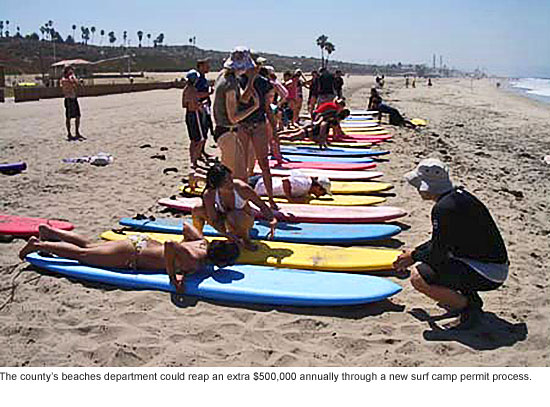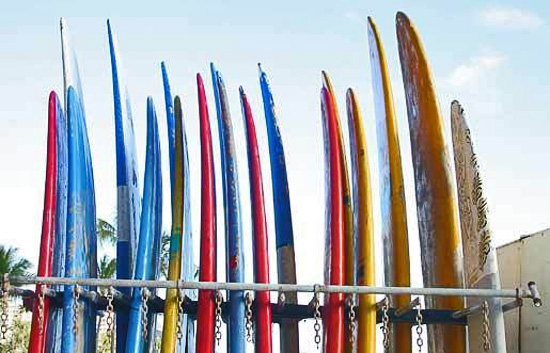How the public won a Malibu sand fight
June 7, 2011
 It started last summer in Malibu with a fight between surf camps and led through a black market to a legislative mystery.
It started last summer in Malibu with a fight between surf camps and led through a black market to a legislative mystery.
But the long, strange trip that this year led Santos Kreimann to the discovery of a mistake that was costing Los Angeles County hundreds of thousands of dollars is now offering the intrepid director of the Department of Beaches and Harbors a possible long-term fix for this summer’s first pressing problem: how to keep the beach bathrooms open and clean.
County beach maintenance workers came under fire last week in one of the more publicized sidebars to the county’s ongoing budget challenges. Amid complaints about scaled-back cleaning schedules, late openings and locked doors at the county’s 52 beach restrooms, Supervisors Zev Yaroslavsky, Gloria Molina and Don Knabe called for alternatives.
The discussion generated headlines and local talk radio furor. On Tuesday, Kreimann presented the Board with a short-term plan to delay some hiring and maintenance and to use marina lease-option and lease-extension fees to open more bathrooms earlier and beef up summer cleaning crews.
Less widely-known, however, was the story behind the long-term proposal Kreimann hopes will help pay for not only the bathroom maintenance, but for other beach services going forward: a change in the county’s longstanding permitting system for recreational beach camps.
At issue, Kreimann says, is the way the county allocates beach space to the hundreds of interest groups that do business on the sand each year, including legions of surf camps and summer recreational programs that traditionally have received permits according to seniority. 
For-profit programs are required to pay a small percentage of their gross receipts in exchange for the permits. That assessment, however, has been waived in past years for city-sponsored programs and non-profit organizations; they’ve paid only a modest administrative fee for the privilege of setting up shop on county beaches. “But there are non-profits, and there are non-profits,” says Kreimann. “Some of these camps charge like $600 a week.”
With public revenues dwindling, he says, those non-profit programs looked like an untapped source of revenue. But when Kreimann, who was appointed director in 2009, inquired about the issue, he was told by staffers who’ve since retired that the nonprofits couldn’t be charged because state law prohibited the county from assessing fees on youth groups.
Then last summer, he says, a surf camp in Malibu resurrected the beach permit question when its owner called to demand that an unpermitted rival be thrown off the sand. “The camp operators got into a physical altercation over allegations that one was operating illegally,” Kreimann says.
Allen King, co-owner of Aqua Surf camp, says the set-to was more like “harassment.” But he confirms that the dispute arose from the beach use permitting policy—in this case, the seniority system, not the fees.
As surf camps had proliferated in recent years, beach permits had become highly valuable, and anyone who had one was reluctant to relinquish it to make space for newcomers. When the City of Santa Monica, where King had operated for more than a decade, decided to decrease surf camp permits to reduce beach crowding, King says, he found it impossible to break into the county beach space.
“We tried to get a county permit, we wrote letters, but it was a closed system,” King says. “Whoever got one first would just hold onto it forever, and nothing moved.”
King’s solution: to cut a deal with a permitted surf camp. He says he offered to expand the business of Kanoa Aquatics, based in the South Bay, by setting up shop to the north, on Surfrider Beach in Malibu under Kanoa’s brand.
After a year, however, the relationship soured, according to both parties, and got downright ugly after King returned to Surfrider—without a permit—the next summer, setting up shop right next to the spot where Kanoa’s owner, Kip Jerger, was now operating on his own.
“I got a little personal,” Jerger acknowledges. “In a way I’m sorry but in a way I’m not. I was like, ‘You guys are like sharks coming in from the ocean.’”
King, meanwhile, says he was just “taking a stand” against an unfair permitting system, only to be confronted by his former colleague. “They were out there yelling, ‘You’re illegal! You’re not allowed to be here!’” King says. “You could have built a reality TV show around it, it was so dramatic. No one got into a fistfight, exactly, but someone did throw a rock at our tent, and we have witnesses.”
Kreimann of the beach department says that when the dispute landed on his desk, he felt compelled to revisit the permitting system. Clearly, beach use had to be limited, but the seniority system was creating problems of its own. Some 50 camps had been waiting years for a spot on one of the beaches, and existing permits had been issued and reissued “with no real safety standards.”
“Multiple people were subcontracting their permits,” he says. “A black market is a pretty good analogy.”
And, he learned, only about 30 of the 162 permit holders were paying a share of their gross receipts to the county because of the state legislation that supposedly prevented the county from charging nonprofits.
“So three or four months ago, I said to my staff person, Penelope Rodriguez, ‘Find that law.’ ”
She couldn’t.
Rodriguez, a program manager, says she quizzed colleagues and searched files and databases, but “we didn’t have the actual bill in any files and nobody remembered the year or the author or what group had introduced it.”
Finally, she says, she traced the confusion to a bill from the mid-1990s that had gotten through the legislature before the governor took issue with a provision that said youth groups not only shouldn’t be assessed like for-profit beach camps, but shouldn’t need the same liability coverage.
“It turned out that the law had been vetoed,” says Kreimann. “We should have been charging them all along.”
Kreimann says the faulty legal assumption was “an oversight” by otherwise hardworking employees, the last of whom retired earlier this year. “The actual law was right there in our file when we went back to check it, but they had misunderstood it. It was one of those things you discover when people leave and you get a new set of eyes.”
Since then, a plan to revamp the system and to set up a competitive selection process for summer permits, based on minimum standards set by the county lifeguards, has been working its way through a series of Beach Commission meetings. A workshop was held in early spring.
Jerger, who has had his beach permit for 14 years, says he understands the need to raise revenue—in fact, he works part-time for the county as a recurrent lifeguard. But he predicts a change in the system will let in more camps and worsen beach crowding, which, thanks to the stalled economy, is already at record levels. (According to the County Fire Department’s lifeguard division, attendance last year topped 68 million, nearly double the 38 million beachgoers counted in 2005-06.)
And levying a percentage of gross receipts on nonprofit recreational programs, he says, could force him to start charging the families of hundreds of disabled and needy children, to whom he’s been giving a break on tuition.
King, on the other hand, says he’s glad to ante up if it means getting a permit.
For his part, Kreimann says the assessment will not only add a measure of fairness and oversight to the beach camp landscape, but could net “in the neighborhood of $500,000 a year, conservatively.”
A recommendation is expected to come before the Board by the end of August. Kreimann says it’s too late for the plan to cover the estimated $372,000 it will cost to revamp the cleaning schedule for this year. But if consensus is reached, it could make the summer of 2012 more convenient and fragrant.
And any surplus could go toward Kreimann’s next plan for getting the most out of the county beaches: “A lot of our parking machines are down a lot of the time, and if we replace them, it could really increase revenue.”
Posted 6/7/11













 405 bridge work causes a stink
405 bridge work causes a stink
